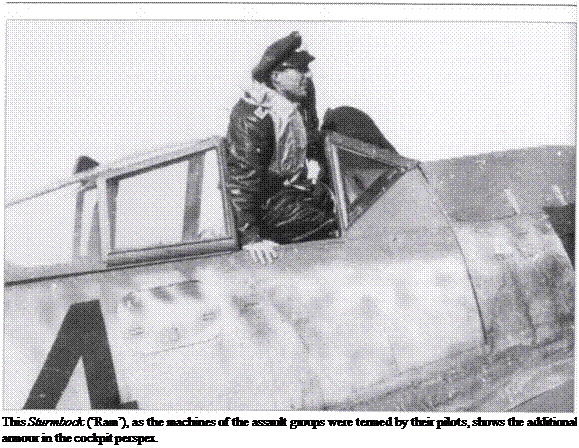. Getting at the Bombers – The Armoured Assault Groups
On 13 October 1943 all personnel of IV./JG 3 paraded on the apron at Neubiberg to hear Reichsmarschall Goring hold forth on the operational record of his fighter pilots. The Gruppe’s Bf 109 G-6 fighters were now to operate with Sturmstaffel 1 as its escort. These assault Gruppen had the task of attacking enemy bomber formations, protected by escort fighters, at close quarters. For this purpose the aircraft had been provided with armour protection against heavy machine-gun fire. The protection covered at least the cockpit, the pilot’s seat and ammunition magazine. Few machines returned without damage after engaging B-17 formations with their immense fire power.
After suffering a period of heavy losses, the unit participated in the Ardennes campaign before arriving at Stargard on 25 January 1945, and from 31 January flew mainly low-level Jabo missions in support of German ground troops. In February the Gruppe received a few Fw 190 D-9s for the first time, but low-level work continued into March when orders came to assume the escort role. The task involved engaging the ever-larger Soviet fighter and light bomber swarms. On 11 March Oak Leaves holder Major Schroer, JG 3 Kommodore, shot down his 104th to 106th victims, and on 15 March he increased his tally to 109. From April 1945 operational readiness at IV.(Sturm)/JG 3 fell drastically. Little enthusiasm could be drummed up for suicide missions, and following sorties in defence of Berlin the survivors fell back to Westerland/Sylt on 2 May.
Learning from the experience of Sturmstaffel 1, OKL applied the basic operational principles to larger groupings, but the assault unit formed from parts

of JG 4 was always fighting a losing battle because of Allied air supremacy. In September 1944 the pilots of II.(Sturm)/JG 4 flew numerous assault missions against the Allied bomber fleets, escorted by III./JG 4’s Fw 190 A-8s. In these often very costly operations the individual assault groups were usually escorted by two Gruppen of Bf 109s. After the Ardennes campaign JG 4 was subordinated to Luftflotte Reich and defended the ever-contracting airspace over the western Reich. On 5 February 1945 Stab and II./JG 4 were at Neuhausen near Cottbus; I./JG 4 at Guben; III. and IV./JG 4 shared Drewitz aerodrome. In March JG 4 had a total of 158 Bf 109s and Fw 190s, often up to 95 per cent operational but short of fuel. For protection III./JG 4 at Berlin Schonefeld and IV.(Sturm)/JG 4 had around 100 blast pens. This latter Gruppe in particular achieved excellent results in its operations against heavy bombers. Of 376 victories claimed, 194 were heavy bombers. The other Gruppen of JG 4 shot down another 205 aircraft of which about 150 were heavy bombers. At the conclusion of the fighting on the Oder, JG 4 pulled back to northern Germany where all Gruppen were disbanded on 1 May.
The last assault Gruppe to be mentioned here was II.(Sturm)/JG 300 whose target was bombers. During the defence of the Reich in 1944, the Gruppe flew many missions with 3. Jagd-Division, and was transferred to 1. Jagd-Division in February. The Stabsstaffel was then at Jiiterbog-Waldlager, II.(Sturm)/JG 300 at Lobnitz, from where it covered central Germany. At the end of 1944 OKL decided that blind-flying training at JG 300 should be discontinued since the unit was to receive the Me 262. On 20 March 1945 OKL decided to disband I. Gruppe immediately and equip the former II.(Sturm)/JG 300 instead with Bf 109 K-4s since there was now a shortage of jets.

On 19 April II. Gruppe moved to Holzkirchen with its 33 Fw 190 D-9s and. D-lls of which only 20 were airworthy. The surviving Fw 190s remained at JG 300 until 3 May 1945, their last flights being over the foothills of the Alps. The assault group concept had great success against Allied bomber formations but the toll in lives was too high. The nature of the operation required pilots to attempt to combat the enemy at very close quarters before turning away sharply
to flee the incoming fighters at the last moment. In employing this tactic many Luftwaffe pilots acted above and beyond the call of duty with disregard for their own fives.










